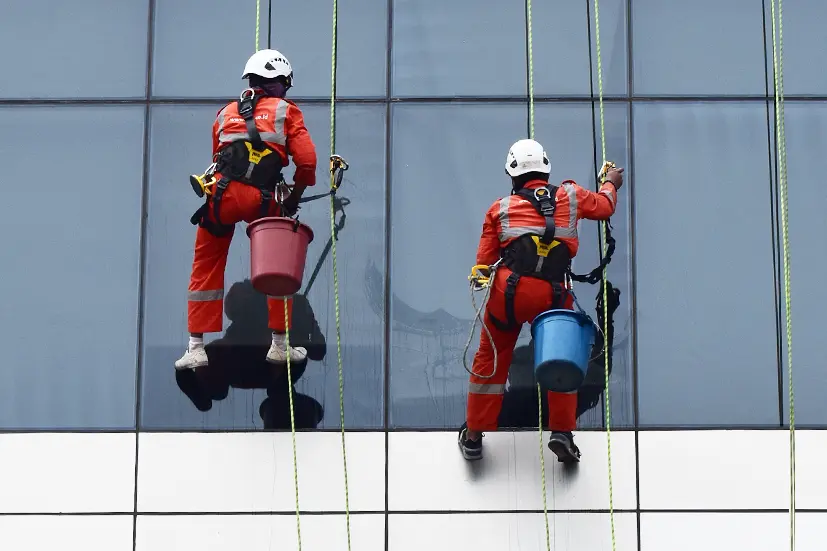5 Glass Building Cleaning Procedures Based on K3 Standards
24 October 2025

Glass building cleaning procedures play a vital role in maintaining the building’s clean and professional appearance, which reflects the company’s image. Working at heights carries high risks, making it essential to implement K3 (Occupational Health and Safety) standards to protect workers and ensure maximum cleaning results.
Let’s take a closer look at the correct procedures for cleaning glass buildings below.
K3 Standards in Glass Building Cleaning
The implementation of K3 standards is mandatory in every glass building cleaning procedure to protect workers from height-related risks. These regulations are outlined in the Minister of Manpower Regulation No. 5 of 1996 on the Occupational Health and Safety Management System. Here’s the breakdown:
1. Company Obligations in Implementing K3
Companies or cleaning service providers must ensure that all workers receive training for working at heights, understand evacuation procedures, and use safety equipment properly.
Regular supervision and equipment inspections are also part of management’s responsibility to guarantee worker safety in the field.
2. Proper Use of Personal Protective Equipment (PPE)
Workers cleaning high areas must be equipped with PPE that complies with K3 standards. This includes:
-
Safety helmets to protect the head from impacts.
-
Harnesses and lifelines to prevent falls.
-
Anti-slip shoes and gloves for better stability and grip.
-
Certified gondolas or scaffolding that meet operational safety standards.
Read Also: 8 Ways to Clean High-Rise Building Windows, Safe & Spotless Shine
Tools and Materials Used in Glass Building Cleaning
Each tool and material serves a specific purpose depending on the height and difficulty of the area being cleaned. Below are the three main categories used in the glass cleaning process:
1. Manual Tools
Used for light cleaning or easily accessible glass surfaces. These include squeegees, mops, scrapers, and microfiber cloths. Their advantages are flexibility, ease of use, and effectiveness in keeping glass surfaces clean without scratches.
2. Mechanical and Modern Equipment
For tall buildings or hard-to-reach areas, support equipment such as water-fed pole systems, scaffolding, and gondolas are used. The latest technology even includes drone cleaning systems, which allow safe and efficient cleaning without compromising performance.
3. Safe Cleaning Solutions
To prevent dullness or damage, non-abrasive cleaners and pure water systems are used to remove dirt without leaving stains. These materials help maintain the glass’s shine and extend its lifespan.
How to Clean High-Rise Building Windows?
To ensure the glass remains spotless and safe, glass building cleaning must follow a structured procedure using the right cleaning equipment. Here’s how internal teams or professional glass cleaners can perform the task:
1. Preparation and Area Inspection
Before starting, ensure the work area is completely safe and ready to use. This inspection prevents accidents and keeps the cleaning process efficient:
-
Check the condition of the glass, frames, and access points. Avoid areas with cracks or loose parts.
-
Monitor weather conditions; postpone work during strong winds, rain, or extreme weather.
-
Set up a safety zone below the work area with warning signs and an emergency evacuation plan.
2. Installing Safety Systems and Equipment
Before cleaning begins, workers must ensure that all safety systems are correctly installed. This step is crucial for safety and to prevent accidents while working at heights:
-
Install gondolas, scaffolding, or rope access systems according to K3 standards, and confirm that all equipment has passed load testing.
-
Use complete PPE such as helmets, harnesses, lifelines, gloves, and anti-slip shoes.
-
Prepare cleaning tools like squeegees, mops, scrapers, and suitable cleaning solutions for the glass material.
3. Cleaning Process
This is the core stage where cleaning techniques determine the final result. Cleaning must be done systematically to avoid stains and minimize risks:
-
Start from the top to bottom to prevent dirty water from dripping onto cleaned surfaces.
-
Use non-abrasive cleaners or a pure water system to avoid scratches.
-
Apply the “S” or vertical squeegee motion for an even, streak-free finish.
4. Drying and Final Inspection
This final step ensures the glass is spotless and the work area is safe afterward. Inspections help detect any areas needing improvement:
-
Dry any remaining water or stains with a microfiber cloth for a perfectly clear result.
-
Check light reflections to ensure there are no scratches, soap marks, or missed spots.
-
Clean up tools, tidy the area, and make sure walkways are safe before leaving the site.
Read Also:12 Must-Have Cleaning Service Tools for Professional Cleanliness
Avoid These Mistakes When Cleaning High-Rise Building Glass
Cleaning high-rise building glass requires precision and strict adherence to safety procedures. Although it may seem simple, several mistakes can cause serious risks for both workers and cleaning quality.
Here are common mistakes to avoid:
1. Not Wearing Complete PPE
Many workers neglect safety equipment because they feel accustomed to heights.
However, not wearing full PPE—such as helmets, harnesses, and anti-slip shoes—significantly increases the risk of fatal accidents.
Additionally, working during strong winds, rain, or extreme weather can affect stability and visibility.
2. Using Harsh Chemicals That Damage Glass Coating
Some cleaning solutions contain abrasive substances that can scratch or erode the protective layer on glass surfaces. Use non-abrasive cleaners and the pure water system for a clear finish without damaging the glass.
3. Neglecting Equipment Inspection and Site Supervision
Routine inspections are often skipped to save time. However, checking the condition of gondolas, safety ropes, and tools is mandatory before and after cleaning.
On-site supervision by a K3 officer is also crucial to ensure that all procedures follow safety standards.
Read Also:7 Office Cleaning Service Tasks for Maximum Cleanliness
Applying K3 standards in glass building cleaning isn’t just about cleanliness—it’s about safety and professional work ethics.
To ensure compliance with regulations, trust SOS, a Jakarta-based outsourcing company with certified workers, regular K3 training, and strict supervision—ensuring safe, efficient, and high-quality glass cleaning operations.
Trust SOS for K3-Compliant High-Rise Glass Cleaning Services
SOS, as a professional building cleaning service provider, employs certified workers who fully understand the procedures and K3 safety standards for cleaning high-rise glass surfaces.
Every process is performed with modern equipment and close supervision to ensure safety and excellent results.
Our advantages:
-
Professional and trained personnel for high-altitude work.
-
Comprehensive field supervision and K3-compliant equipment usage.
-
Optimal cleaning results without compromising safety.
Contact SOS today for safe, efficient, and K3-standard high-rise glass cleaning solutions.



